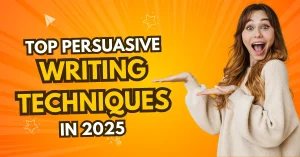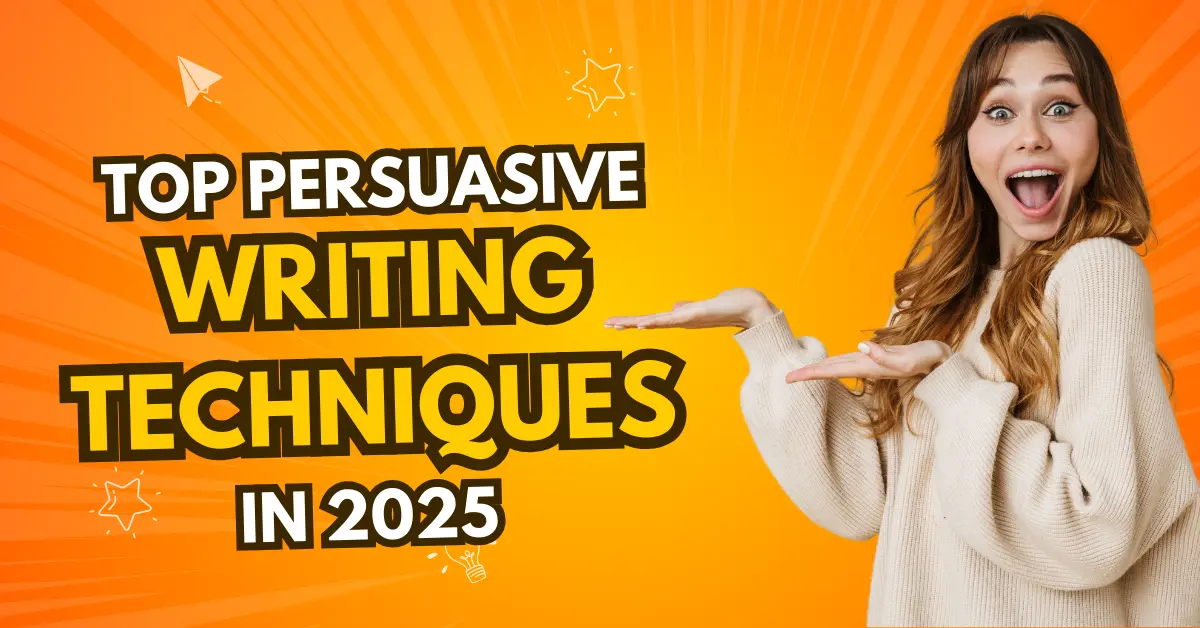In 2025, persuasive writing techniques is more powerful than ever. Whether you’re crafting an academic essay, marketing a product, or presenting an idea, the way you shape your message can influence how others think and act. With growing digital content and shrinking attention spans, knowing the right persuasive writing techniques is not just helpful – it’s essential.
At AllAssignmentHelp.org, we help students and professionals build writing skills that persuade. In this blog, we break down the top persuasive strategies of 2025, supported by real examples, expert advice, and techniques tailored to today’s audience.
-
What Is Persuasive Writing?
- 1. Master the Core: Rhetorical Appeals (Ethos, Pathos, Logos)
- 2. Understand Your Reader: Audience Engagement
- 3. Craft a Clear Argument Structure
- 4. Use Persuasive Language Devices
- 5. Leverage the Power of Storytelling in Persuasion
- 6. Use Digital-Age Persuasion Tactics
- 7. The Role of Call to Action (CTA) in Writing
- 8. Modern Persuasive Methods: 2025 Trends
- 9. Tone and Style in Persuasive Writing
- 10. Word Choice Makes a Big Impact
- 11. Persuasive Techniques in Advertising vs Academic Writing
- 12. Persuasive Speech Techniques for Writing
- 13. Examples of Persuasive Writing in Assignments
- 14. Writing for Influence: Beyond Essays
- Final Thoughts: The Future of Persuasion
- Frequently Asked Questions
What Is Persuasive Writing?
Persuasive writing means using words to convince a reader to agree with your view or take an action. It blends logic, emotion, structure, and storytelling to guide a reader’s thoughts.
From persuasive essay writing to social media ads, these skills apply across formats. The aim? Get your audience to believe, feel, or do something.
1. Master the Core: Rhetorical Appeals (Ethos, Pathos, Logos)
Ethos – Build Trust
Use credible facts, expert quotes, or your own experience to show you know your topic. When the audience sees you as trustworthy, they listen.
Example: “As a student who faced academic stress, I understand how tough writing can be.”
Pathos – Appeal to Emotion
Use relatable language, real-life situations, or stories to trigger emotions. Emotional appeal in writing helps readers feel connected.
Example: “Imagine staying up all night, staring at a blank screen with a deadline just hours away.”
Logos – Use Logic
Support your claims with logic and clear evidence. Logical reasoning in arguments is key to persuasion.
Example: “Studies show students who plan their essays score 25% higher.”
2. Understand Your Reader: Audience Engagement
In 2025, writing for influence means writing to someone, not just at them.
- Use second-person voice: “You might be wondering…”
- Ask questions: “Have you ever felt stuck while writing an assignment?”
- Offer solutions: “Here’s how you can fix that, step by step.”
Tip: Understand your audience’s age, needs, problems, and reading level.
3. Craft a Clear Argument Structure
A good argument has a beginning, middle, and end. Use this basic structure:
- Introduction: State your main point or claim
- Body: Present 2–3 clear reasons with support
- Counterargument: Address and refute an opposite view
- Conclusion: Repeat your point with a strong call to action (CTA)
Bonus Tip: Break paragraphs into 3–4 lines max for easy reading.
4. Use Persuasive Language Devices
Words have power. In 2025, persuasive techniques in writing are moving towards simpler, clearer language.
- Repetition: Reinforce key points: “You can improve. You will improve. You deserve better.”
- Emotive words: Choose words that spark feeling: “helpless”, “relief”, “freedom”
- Power verbs: Act, solve, build, change, lead, boost
- Direct commands: “Start writing now. Don’t delay.”
- Inclusive language: “We understand. We help.”
Read more: Emotive Language
5. Leverage the Power of Storytelling in Persuasion
People connect with stories more than facts.
Example of persuasive writing:
“Back in 2020, Sarah failed her first university essay. She felt lost. By 2023, she graduated with honours, thanks to personalised support from academic writers. Her journey shows how expert help makes a real difference.”
Use simple stories that:
- Include a real problem
- Show a turning point
- End with a result
This method boosts audience engagement and increases dwell time — a key SEO metric.
6. Use Digital-Age Persuasion Tactics
In the digital world, attention is short. Your writing must hook fast and stay relevant.
Strategies That Work in 2025:
- Short paragraphs: 2–4 lines max
- Bullet points and subheadings for scan ability
- Conversational tone to feel human
- Internal links to keep users on-site longer
Pro Tip: Use formatting like bold and italics to highlight key points.

7. The Role of Call to Action (CTA) in Writing
A CTA is what you want your reader to do next.
Examples:
- “Submit your essay now for expert review.”
- “Download your free writing checklist.”
- “Chat with a writing expert today.”
CTAs must:
- Be short and clear
- Use action verbs
- Match the content’s tone
8. Modern Persuasive Methods: 2025 Trends
- Emotional Authenticity
Avoid fake emotion. Be real. Share real stories. Real emotion connects better than exaggeration.
- Data-Driven Persuasion
Support claims with real stats. But keep them simple.
“Over 65% of students now use assignment support services to improve grades.”
- User-Focused Value
Make it clear what the reader gets from reading.
“By using these persuasive writing techniques, your grades will improve.”
9. Tone and Style in Persuasive Writing
Your tone should match your brand. For academic content:
- Be friendly but professional
- Use plain language
- Avoid slang or overused phrases
Right tone example:
“We help Australian students master persuasive writing with clarity, structure, and expert tips.”
10. Word Choice Makes a Big Impact
The impact of word choice in persuasive writing is huge.
Use:
- Common, short words
- Words with one meaning (avoid complex or abstract terms)
- Specific words (e.g., “essay” not “academic document”)
Avoid:
- Passive voice
- Vague terms
- Repetitive filler
11. Persuasive Techniques in Advertising vs Academic Writing
Advertising focuses on emotion and fast action. Academic writing focuses on logic and structured reasoning.
But both share tools:
- Clear structure
- CTA
- Emotional appeal
- Word power
At AllAssignmentHelp.org, we teach you how to balance both depending on your goal.
12. Persuasive Speech Techniques for Writing
Even in writing, speech techniques work:
- Rhetorical questions: “Wouldn’t better grades make life easier?”
- Tripling: “Plan. Write. Win.”
- Pausing: Use full stops to create rhythm.
These devices keep writing punchy and engaging.
13. Examples of Persuasive Writing in Assignments
- Opening Paragraph
“Many students in Australia feel stuck with writing tasks. But there’s a smarter way to manage assignments with expert help.”
- Body with Logos and Pathos
“By improving structure and emotional tone, essays become more convincing. This leads to higher grades and better feedback.”
- Closing with CTA
“Ready to write better? Submit your first draft today and get expert feedback.”
14. Writing for Influence: Beyond Essays
Persuasive writing isn’t just for essays. It applies to:
- Blogs
- Presentations
- Social media
- Emails
- Business reports
If your goal is to guide, inform, or inspire – persuasive writing helps.
Read more: What is a PEEL Paragraph
Final Thoughts: The Future of Persuasion
The best persuasive writing techniques in 2025 focus on clarity, connection, and action. Whether you’re a student or a marketer, your words must:
- Be clear
- Feel human
- Drive change
At AllAssignmentHelp.org, we support learners across Australia in mastering modern writing strategies. With expert guidance, even tough writing tasks become manageable and enjoyable.
Frequently Asked Questions
What makes persuasive writing work in 2025?
Good persuasive writing in 2025 is clear and simple. It uses facts, feelings, and trust to make readers agree. It also talks to the reader in a friendly way and ends with a strong message or action.
How can I use persuasive writing in my school work?
Start with a clear idea. Use facts, real stories, and strong words to support your point. Speak to the reader. Ask questions and keep your sentences short. Always end with what you want the reader to do.
Why should students learn persuasive writing?
Persuasive writing helps you share your ideas. It makes your school work stronger. You can use it in essays, speeches, or letters. It also helps you talk better in real life.









